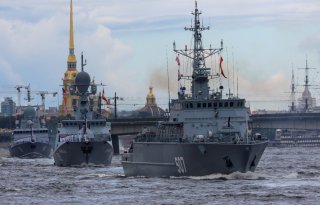Navy Day: Putin’s New Russian Fleet Has a Message for NATO
This year’s lineup reflects the Russian Navy’s slow-but-deliberate shift away from the hulking cruisers and destroyers of the Soviet era in favor of a leaner and smaller rapid-response force.
On Sunday, Russia held a large-scale parade in St. Petersburg to mark Navy Day.
This year’s parade featured forty-seven naval vessels and over forty naval aviation aircraft, according to Russian state news outlet TASS. The parade, which was attended by Russian president Vladimir Putin and Defense Minister Sergey Shoigu, was headlined by the lead ship of the Admiral Gorshkov class of modern frigates, Admiral Gorshkov. Gorshkov will be the first ship to carry Russia’s new 3M22 Tsirkon winged hypersonic anti-ship cruise missile, Putin said in a speech. The Tsirkon missile is reportedly capable of reaching speeds up to Mach 9, or around 6,900 miles per hour, and features an operational range of around 620 miles. The Tsirkon hypersonic missile was one of the six advanced weapons unveiled by Putin during his 2018 annual state-of-the-nation address.
The naval procession included the modern Karakurt-class corvette Odintsovo, Buyan-M class corvettes Zelyony Dol and Velikiy Ustyug, Nanuchka-class corvette Passat, Steregushchy-class corvettes Boikiy, Stoikiy, and Soobrazitelnyy, Project 11711 landing ship Ivan Gren, Yasen-class Severodvinsk nuclear-powered cruise missile submarine, and Akula-class nuclear-powered attack submarine Magadan. The event’s naval aviation roster consisted of Mi-8, Ka-31R, Ka-29, and Ka-27M military helicopters, an Il-38 anti-submarine warfare (ASW) aircraft, Tu-142 ASW aircraft, Mig-31 interceptor aircraft, Su-24 bombers, and a Su-25 ground attack aircraft. A total of 3,500 military personnel participated in the St. Petersburg parade.
This year’s lineup reflects the Russian Navy’s slow-but-deliberate shift away from the hulking cruisers and destroyers of the Soviet era in favor of a leaner and smaller rapid-response force composed largely of modernized corvettes, frigates, and nuclear-powered submarines.
Navy Day was first established in 1939 as an annual Soviet holiday to “mobilize the working masses around the construction of a Workers’ and Peasants’ Soviet Navy.” Navy Day was canceled in 1980, just under a decade before the Soviet collapse, and reinstated in 2006 by a decree issued by Putin.
Plans to hold Navy Day celebrations in Russian-annexed Crimea were scrapped following reports of a Ukrainian drone attack on the headquarters of Russia’s Black Sea Fleet in Sevastopol. Governor Mikhail Razvozhayev said six Black Sea Fleet employees were injured following the alleged strike, adding that all festivities scheduled on that day were “canceled for security reasons.” The Black Sea fleet’s press service later said the attack was carried out by a makeshift drone carrying a “low-powered” explosive device. Top Ukrainian officials denied any involvement in the incident, dismissing the Russian allegation as a “sheer provocation.”
Mark Episkopos is a national security reporter for the National Interest.
Image: Reuters.

